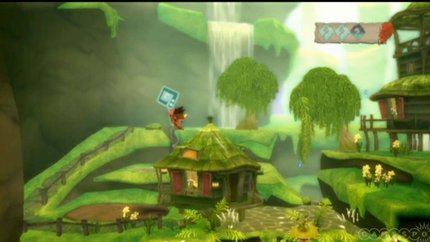LostWinds was a WiiWare launch game that was full of promise, but despite some genuine innovation, it failed to deliver across the course of its adventure. Now one year later, the sequel, LostWinds: Winter of the Melodias, is a vast improvement over its predecessor. The controls have been tightened, the dull indoor sections have disappeared, and the game has been lengthened. It's still not perfect, because it doesn't explain how to use your abilities correctly, but there's more than enough great platforming and puzzle-solving to make it worthy of your 1,000 Wii points.
Once again, you take on the role of Toku, accompanied by his wind spirit friend, Enril. Toku discovers that his mother has disappeared and the only clue to her whereabouts is a misplaced page from her journal. With the help of the rock giant Magmok, you set off to the Summerfalls mountains to discover what happened to your mother and a tribe of people known as the Melodias. The story is much improved over the original, with better dialogue and cutscenes--you'll actually feel inclined to uncover the mystery and progress through the narrative.
You control Toku with the nunchuk's analogue stick, while you control Enril with the Wii Remote's pointer. Toku can't do much on his own except walk up small ledges, so he needs to use the power of the wind to traverse the environment and solve puzzles. Sweeping the remote whilst holding down the A button activates the wind, with upward gusts used to make Toku jump. You feel godlike in your control of Toku--a sweep of the Wii Remote controls his every action, which really mixes up the platforming and puzzle-solving elements. The controls have been tightened up considerably since the last game, and the inaccuracies that plagued the motion controls have mostly been eradicated. You should have no trouble guiding Toku around the levels, because wind movements always register in the correct direction.

The wind is the key to solving many of the game's puzzles, and you're periodically introduced to a new ability to make things interesting. Though the abilities are easy to pull off, the explanations on how to perform them could be a little clearer. For example, to use the levitation ability you throw an object in the air, and then draw a circle around it. Only drawing the circle is explained, the first step of throwing the object in the air is missed out. The most interesting new feature is the ability to change the season from winter to summer. This affects the environment, unfreezing pools of water and allowing you to reach previously impassable areas. For example, one area required us to guide a character to a very tall platform, and by turning the weather to summer we were able to use a vortex to suck up the water from a nearby lake, drop it into the adjacent area, and then turn the weather back to winter again. The water then froze, filling the gap to the tall platform to cross. This is the key to solving many of the puzzles later on, and it leads to some very satisfying moments--it's just a shame that the ending features a cheap boss that doesn't match up to the cleverness of earlier puzzles.
It's clear that much work has been done to get away from the murky indoor environments of the first game. Most of the action takes place outdoors in daylight, which results in a vibrant and colorful look. Trees blow in the wind, water glistens in the sun, and mountains stretch off into the distance. The winter environments also look great, with Toku's footsteps kicking up snow from the ground amongst the frozen waterfalls and firelit paths. Navigating the lush environments is made much easier this time by the addition of a map, helping to keep track of areas you have visited and the current objective. You're also treated to a traditional Japanese-style soundtrack, reminiscent of the music in Okami. The music fits well with the style of the game, and overall the audio has a calming effect as you rack your brain on the puzzles. We managed to breeze through the game in a little over five hours, though it can be stretched out longer if you try collecting the 48 hidden objects scattered across the levels.

With great artistic style, clever puzzles, and tighter motion controls, Winter of the Melodias improves on the original in just about every way. The story keeps you entertained throughout and the hidden objects add replay value to its five hour length, and the fact it costs just 1,000 Wii Points is icing on the cake. If you're after a unique and highly entertaining take on the humble platformer with cleverly designed puzzles, then Winter of the Melodias comes highly recommended.